Complete Solutions to Critical Thinking of chapter TRANSMISSION OF HEAT of Class 11 book with complete answers and questions
| Class 11 | PHYSICS |
| Chapter | TRANSMISSION OF HEAT |
| ERRORLESS | Critical Thinking |
| Number Of Questions | 36 |
| Academic Year | 2023-24 |
Two rods (one semi-circular and other straight) of same material and of same cross-sectional area are joined as shown in the figure. The point A and B are maintained at different temperature. Find the ratio of the heat transferred through a cross-section of a semi-circular rod to the heat transferred through a cross section of the straight rod in a given time.
 03:07View Solution
03:07View SolutionA wall has two layers A and B each made of different materials. Both the layers have the same thickness. The thermal conductivity of materials A is twice of B. Under thermal equilibrium temperature difference across the layer B is `36^@C`. The temperature difference across layer A is
05:16View SolutionIce starts forming in lake with water at `0^(@)C` and when the atmospheric temperature is `-10^(@)C`. If the time taken for `1 cm` of ice be `7` hours. Find the time taken for the thickness of ice to change from `1 cm` to `2 cm`
09:24View SolutionA cylinder of radius `R` made of a material of thermal conductivity `K_(1)` is surrounded by cylindrical shell of inner radius `R` and outer radius `2R` made of a material of thermal conductivity `K_(2)` The two ends of the combined system are maintained at two different temperatures There is no loss of heat across the cylindrical surface and system is in steady state What is the effective thermal conductivity of the system
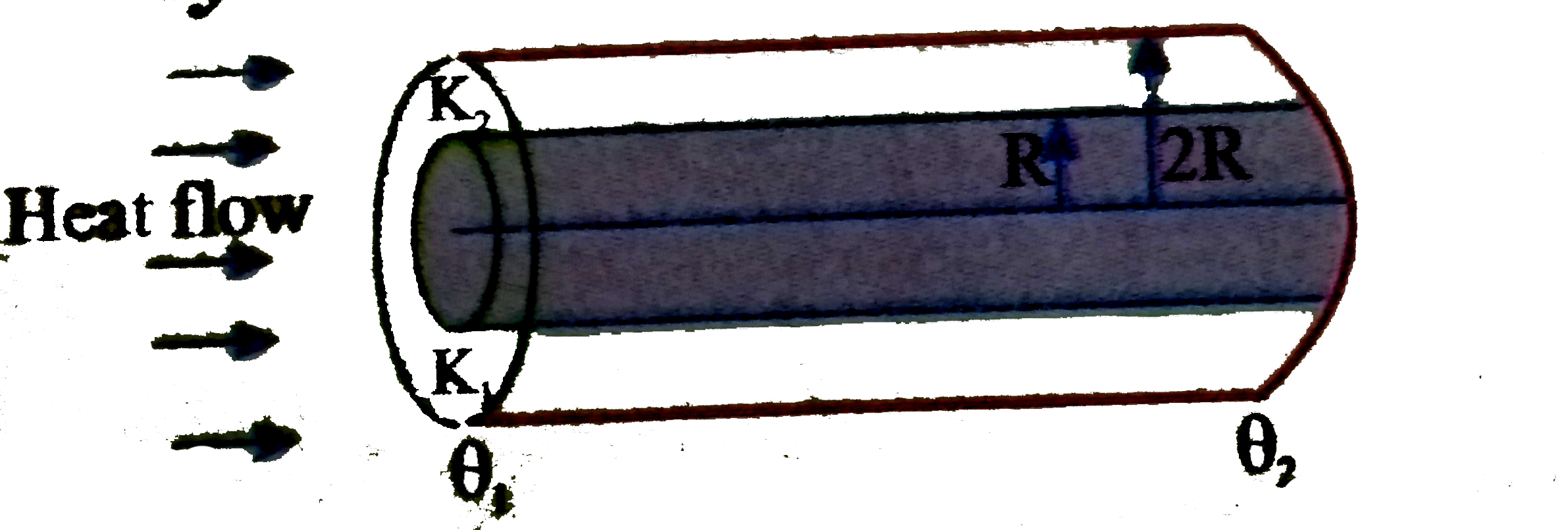 .04:13View Solution
.04:13View SolutionThree rods made of the same material and having the same cross-section have been joined as shown in the figure. Each rod is of the same length. The left and right ends are kept at `0^@C` and `90^@C`, respectively. The temperature of junction of the three rods will be
(a) `45^@C` (b) `60^@C`
(c) `30^@C` (d) ` 20^@C`.
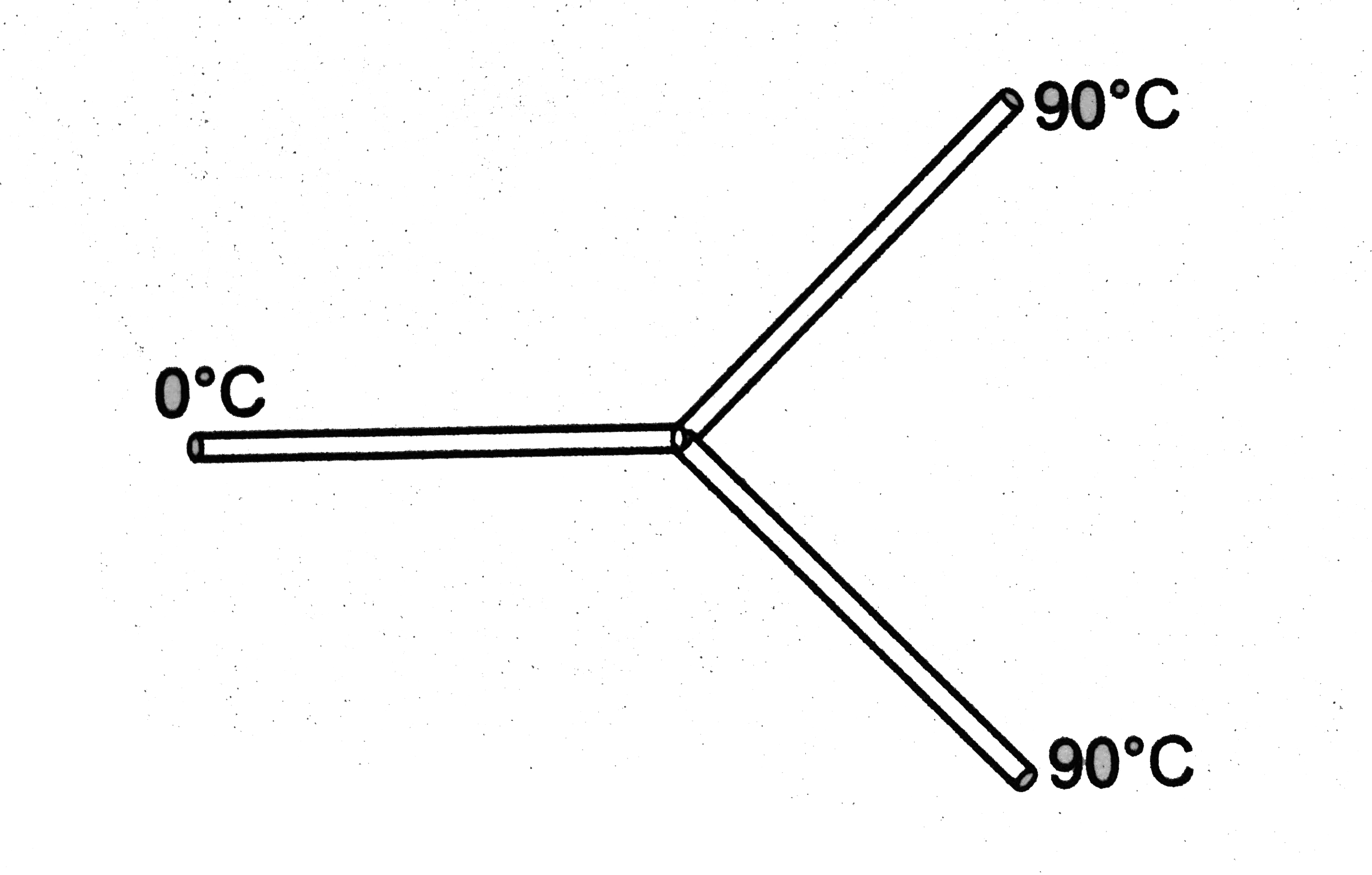 02:35View Solution
02:35View SolutionA room at `20^@C` is heated by a heater of resistence 20 ohm connected to 200 VV mains. The temperature is uniform throughout the room and the heati s transmitted through a glass window of area `1m^2` and thickness 0.2 cm. Calculate the temperature outside. Thermal conductivity of glass is `0.2 cal//mC^@` s and mechanical equivalent of heat is `4.2 J//cal`.
05:54View SolutionThere is formation of layer of snow x cm thick on water, when the temperature of air is `-theta^(@)C` (less than freezing point). The thickness of layer increases from x to y in the time r, then the value of t is given by
03:14View SolutionA composite metal bar of uniform section is made up of length 25 cm of copper, 10 cm of nickel and 15 cm of aluminium. Each part being in perfect thermal contact with the adjoining part. The copper end of the composite rod is maintained at `100^(@)"C"` and the aluminium end at `0^(@)"C"`. The whole rod is covered with belt so that there is no heat loss occurs at the sides. If `K_(Cu) = 2K_(Al)" and" " K"_(Al) = 3"K"_(Ni)`, then what will be the temperatures of `Cu- Ni` and `Ni -Al` junctions respectively
 04:54View Solution
04:54View SolutionThree rods of identical cross-sectional area and made from the same metal from the sides of an isosceles triangle ABC, right-angled at B. The point A and B are maintained at temperatures T and `sqrt(2)` T respectively. In the steady state, the temperature of the point C is `T_c.` Assuming that only heat conduction takes places, `T_c//T` is
04:59View Solution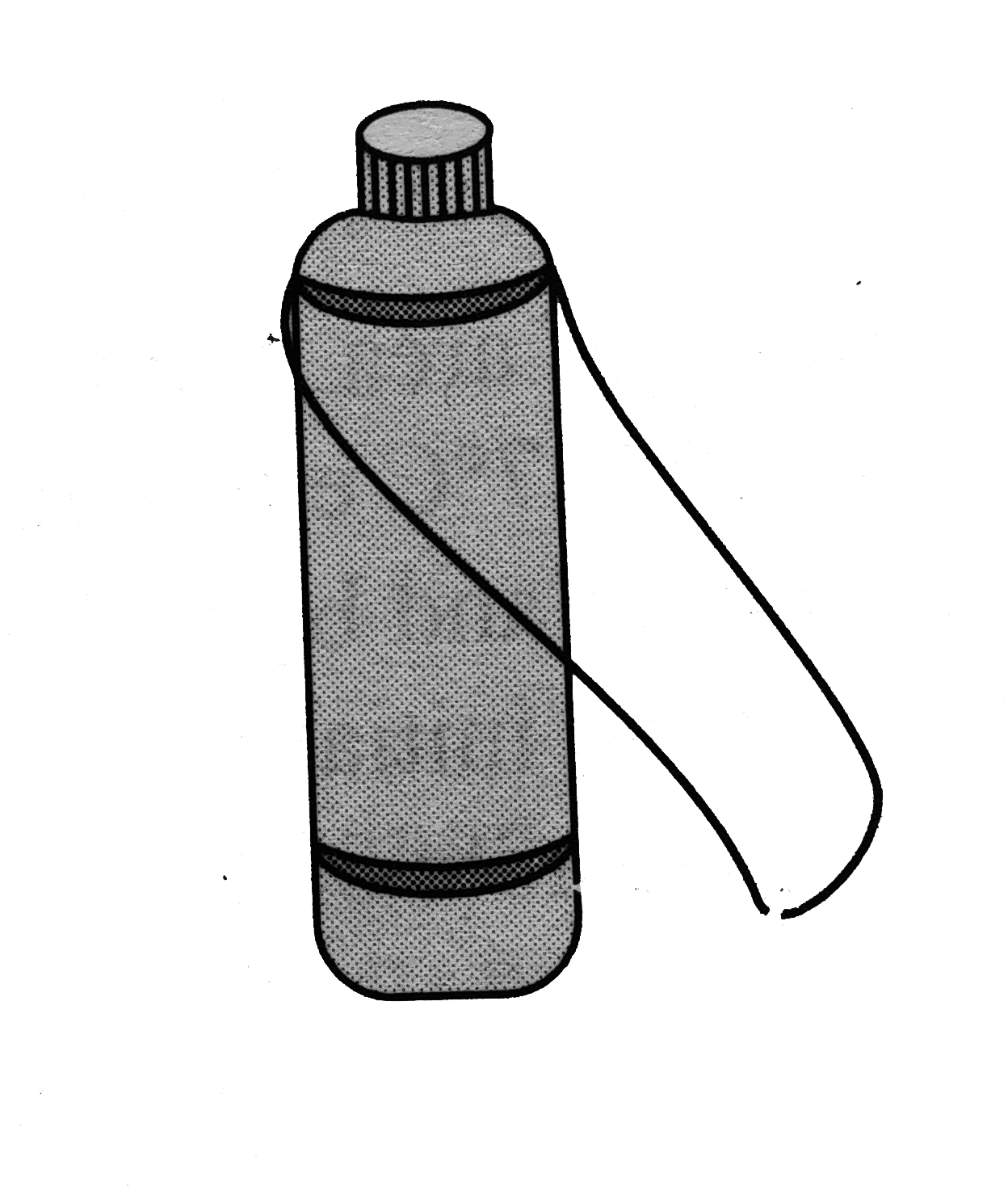
The only possibility of heat flow in a thermos flask is through its cork which is `75cm^2` in area and 5 cm thick its thermal conductivity is `0.0075 cal//cm-s-^@C`. The outside temperature is `40^@C` and latent heat of ice is `80 cal//g`. Time taken by 500 g of ice at `0^@C` in the flask to melt into water at `0^@C` is `04:28View SolutionA sphere a cube and thin circular plate, all made of the same material and having the same mass are initially heated to a temperature of `1000^(@)C`. Which one of these will cool first?
02:33View SolutionTwo identical conducting rods are first connected independently to two vessels, one containing water at `100^@C` and the other containing ice at `0^@C`. In the second case, the rods are joined end to end and connected to the same vessels. Let `q_1 and q_2` gram per second be the rate of melting of ice in the two cases respectively. The ratio `q_1/q_2` is
(a) `1/2` (b)`2/1` (c)`4/1` (d)`1/4`04:37View SolutionA solid cube and a solid sphere of the same material have equal surface area. Both are at the same temperature `120^(@)C`, then
03:25View SolutionTwo bodies A and B have thermal emissivities of 0.01 and 0.81 respectively. The outer surface areas of the two bodies are same. The two bodies emit total radiant power at the same rate. The wavelength `lambda_B` corresponding to maximum spectral radiancy from B is shifted from the wavelength corresponding to maximum spectral radiancy in the radiation from A by 1.0 `mum`. If the temperature of A is 5802 K, calculate (a) the temperature of B, (b) wavelength `lambda_B`.
08:27View SolutionA black body is at a temperature of 2880 K. The energy of radiation emitted by this object with wavelength between 499 nm and 500 nm is`U_(1)`, between 999 nm and 1000 nm is `U_(2)` and between 1499 nm and 1500 nm is `U_(3)`. The Wein's constant `b = 2.88 xx 10^(6) "nm K"`. Then
03:02View SolutionA black metal foil is warmed by radiation from a small sphere at temperature `T` and at a distance d it is found that the power received by the foil is `P` If both the temperature and the distance are doubled the power received by the foil will be .
02:54View Solution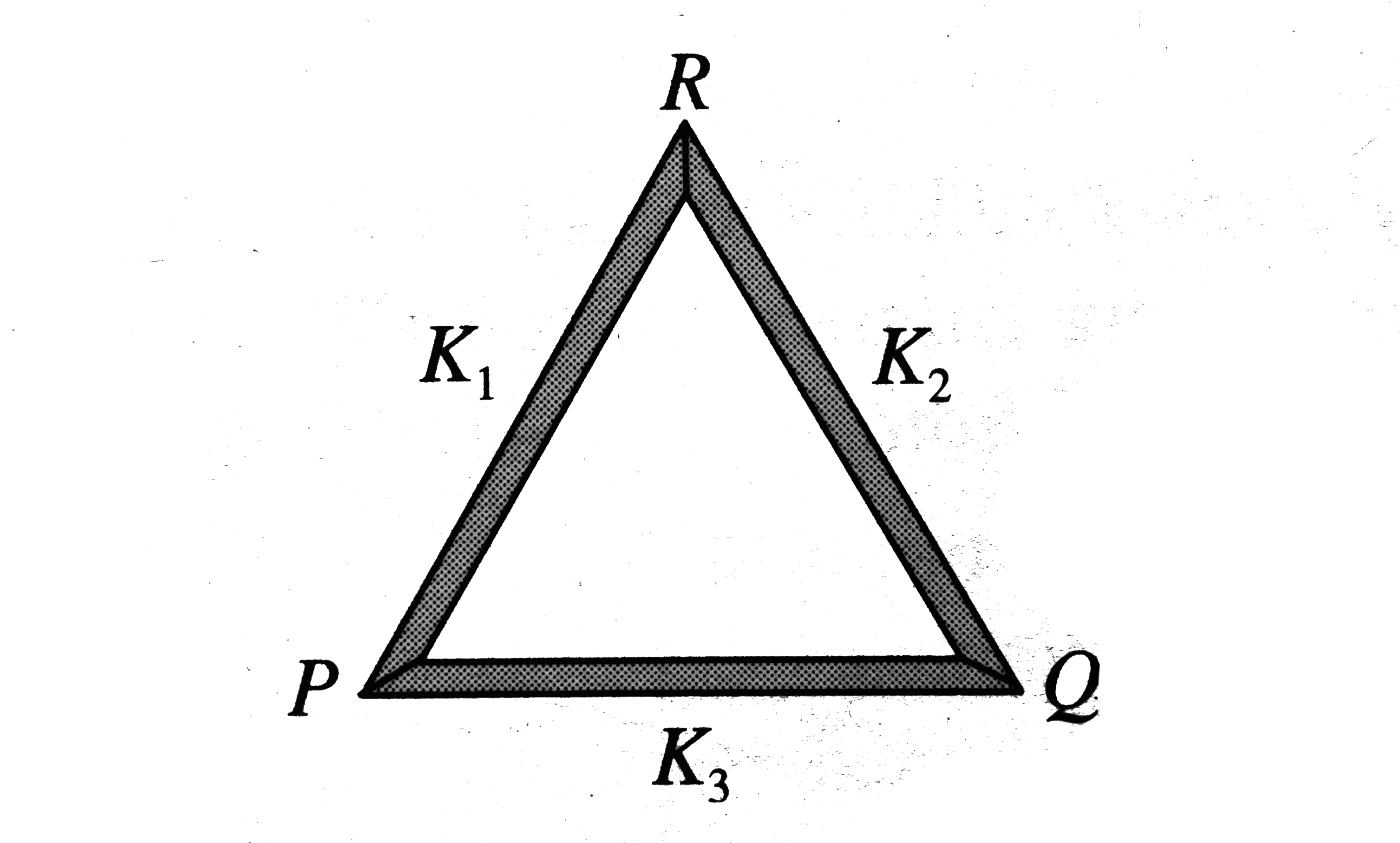
Three rods of same dimensions are arranged as shown in Fig. They have thermal conductivities `K_1`,`K_2` and `K_3`. The points P and Q are maintained at different temeperature for the heat to flow at the same rate along PRQ and PQ. Whi of the following options correct?04:28View SolutionTwo metallic spheres `S_1 and S_2` are made of the same material and have got identical surface finish. The mass of `S_1` is thrice that of `S_2`. Both the spheres are heated to the same high temperature and placed in the same room having lower temperature but are thermally insulated from each other. the ratio of the initial rate of cooling of `S_1` to that of `S_2` is
`(a)1/3 (b)1/(sqrt3) (c) (sqrt3)/1 (d) (1/3)^(1/3)`03:22View SolutionThree discs, A, B and C having radii 2m, 4m and6m respectively are coated with carbon black on their outer surfaces. The wavelengths corresponding to maximum intensity are `300nm, 400nm` and `500 nm`, respectively. The power radiated by them are `Q_A, Q_B and Q_C` respectively
(a) `Q_A` is maximum (b) `Q_B` is maximum (c) `Q_C` is maximum (d) `Q_A = Q_B = Q_C`03:02View SolutionThe total energy radiated from a block body source at constant temperature is collected for one minute and is used to heat a quantity of water. The temperature of water is found to increase from `20^(@)C` to `20.5^(@)C`. If the absolute temperature of the blackbody is doubled and the experiment is repeated with the same quantity of water of `20^(@)C`, the temperature of water will be:
04:18View SolutionA solid sphere and a hollow sphere of the same material and of equal radii are heated to the same temperature
02:07View SolutionA solid copper cube of edges 1 cm is suspended in an evacuated enclosure. Its temperature is found to fall from `100^@C` to `99^@C` in 100 s. Another solid copper cube of edges 2 cm, with similar surface nature, is suspended in a similar manner. The time required for this cube to cool from `100^@C` to `99^@C` will be approximately
07:56View SolutionA body initially at `80^(@)" C"` cools to `64^(@)" C"` in 5 minutes and to `52^(@)"C"` in 10 minutes. The temperature of the body after 15 minutes will be
05:13View SolutionA `5 cm` thick ice block is there on the surface of water in a lake. The tmeperature of air `- 10^(@)C`, how muct time it will take to double the thickness of the block?
`(L = 80 cal//g, K_(ice) = 0.004 cal//s-K, d_(ice) = 0.92 g cm^(-3))`02:51View SolutionA square is made of four rods of same material one of the diagonal of a square is at temperature difference `100^@C`, then the temperature difference of second diagonal:
02:48View SolutionA cylindrical rod with one end in a steam chamber and the other end in ice results in melting of 0.1 g of ice per second. If the rod is replaced by another with half the length and double the radius of the first and if the thermal conductivity of material of second rod is 1/4 that of first, the rate at which ice melts in `g//s` will be
05:52View SolutionOne end of a copper rod of length 1.0 m and area of cross-section `10^(-3)` is immersed in boiling water and the other end in ice. If the coefficient of thermal conductivity of copper is `92 cal//m-s-.^(@)C` and the latent heat of ice is `8xx 10^(4) cal//kg`, then the amount of ice which will melt in one minute is
03:36View SolutionAn ice box used for keeping eatables cool has a total wall area of `1m^2` and a wall thichness of 5.0 cm. The thermal cunductivity of the ice box is `K=0.01 J//m^@C`. It is filled with large amount of ice at `0^@C` along with eatables on a dfay when the temperature is `30^@C` The latent heat of fusion of ice is `334xx10^3 J//kg`. The amount of ice melted in one day is ( 1 day`=86,000s`)
03:07View SolutionFive rods of same dimensions are arranged as shown in the figure. They have thermal conductivities `K _(1) , K_(2) , K _(3) , K_( 4)` and `K_( 5)` . When points A and B are maintained at different temperatures, no heat flows through the central rod if
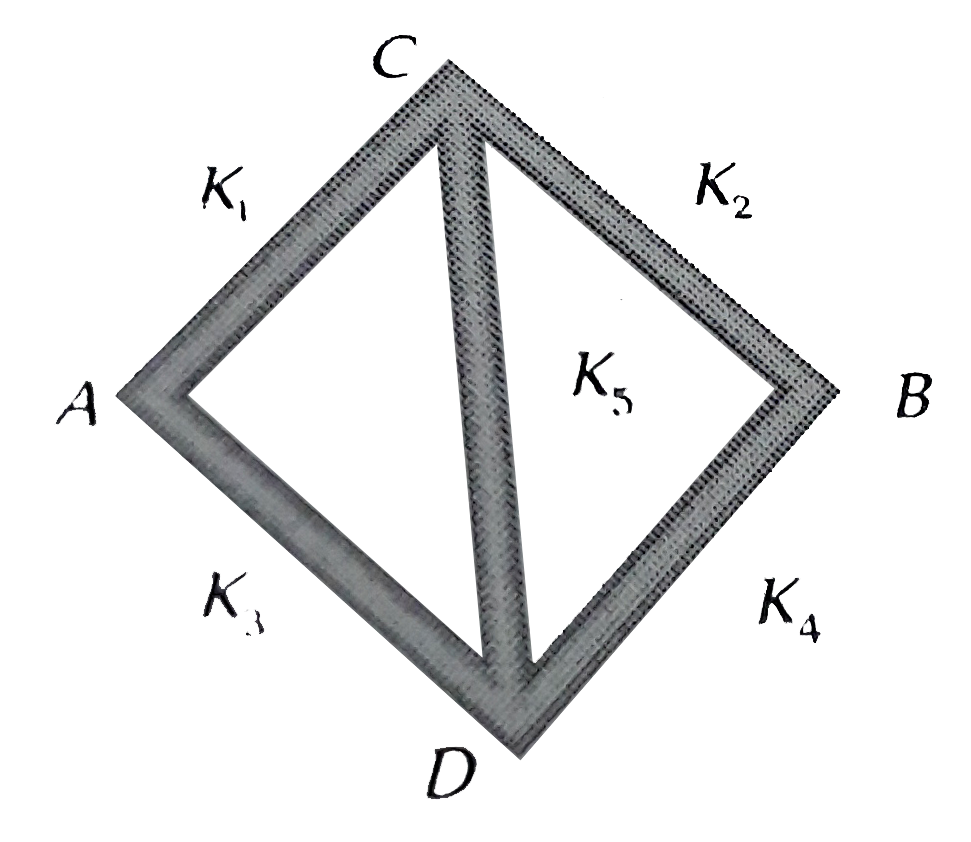 05:39View Solution
05:39View SolutionA hot metallic sphere of radius r radiates heat. It's rate of cooling is
03:06View SolutionA solid copper sphere (density rho and specific heat c) of radius r at an initial temperature `200K` is suspended inside a chamber whose walls are at almost `0K.` The time required for the temperature of the sphere to drop to 100K is …….
09:23View SolutionOne end of a copper rod of uniform cross-section and of length 3.1 m is kept in contact with ice and the other end with water at `100° C` . At what point along it's length should a temperature of `200° C` be maintained so that in steady state, the mass of ice melting be equal to that of the steam produced in the same interval of time. Assume that the whole system is insulated from the surroundings. Latent heat of fusion of ice and vaporisation of water are 80 cal/gm and 540 cal/gm respectively
 07:21View Solution
07:21View SolutionA sphere and a cube of same material and same volume are heated up to same temperature and allowed to cool in the same sorroundings. The radio of the amounts of radiations emitted in equal time intervals will be
05:45View SolutionThe temperature of the two outer surfaces of a composite slab, consisting of two materials having coefficients of two materials having coefficients of thermal conductivity K and 2K and thickness x and 4x, respectively, are `T_2 and T_1(T_1gtT_1)`. The rate of heat transfer through the slab, in a steady state is `((A(T_2-T_1)K)/2)f`, with f equal to
 02:31View Solution
02:31View SolutionThe figure shows a system of two concentric spheres of radii `r_1 and r_2` are kept at temperature `T_1 and T_2`, respectively. The radial rate of flow of heat in a substance between the two concentric spheres is proportional to
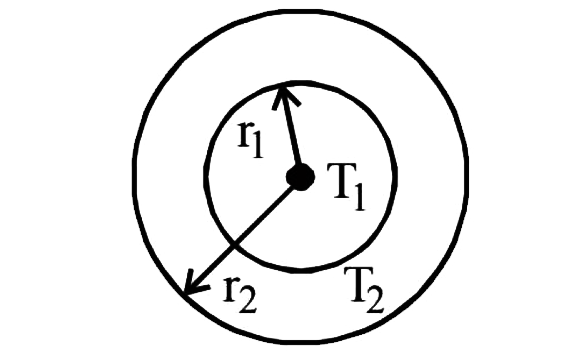 03:50View Solution
03:50View SolutionFour rods of identical cross-sectional area and made from the same metal form the sides of square. The temperature of two diagonally opposite points are T and`sqrt( 2)T` respectively in the steady state. Assuming that only heat conduction takes place, what will be the temperature difference between other two points
04:17View Solution
Critical Thinking questions and complete solutions for chapter TRANSMISSION OF HEAT of UNIVERSAL BOOK DEPOT 1960 PHYSICS (HINGLISH) of Class 11
